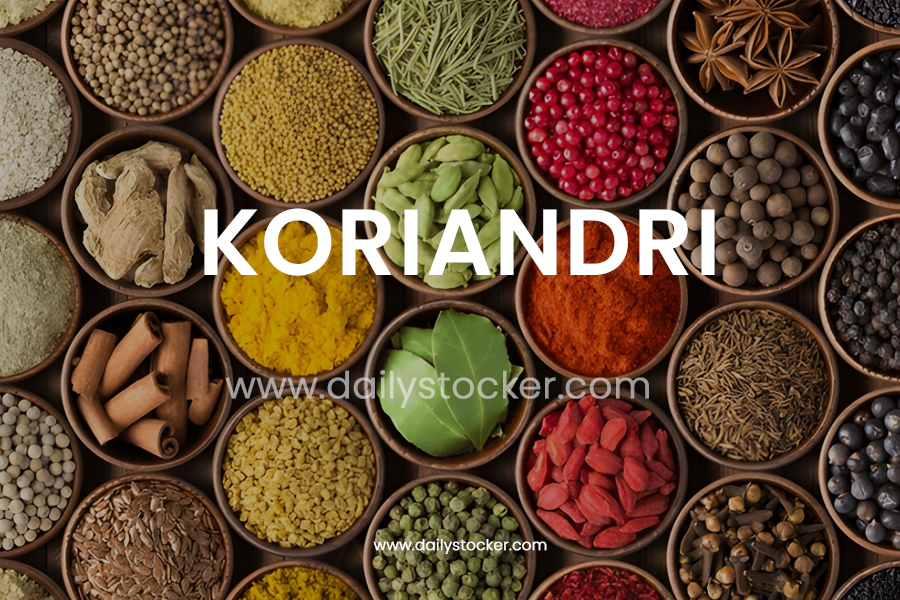Koriandri: The Flavorful Herb with Timeless History, Wellness Benefits, and Global Appeal
When people talk about koriandri, they often describe it as the vibrant, citrusy heartbeat of a dish—a fresh, aromatic burst that transforms simple meals into unforgettable experiences. Known globally by many names, such as coriander, cilantro, dhania, or even Chinese parsley, this humble herb is far more than a garnish. It has roots in ancient Egyptian herbs, traveled along the spice trade routes, and remains a cherished part of culinary diversity across continents.
From coriander seeds vs leaves, which offer very different flavors, to its reputation as a source of vitamins ,A, C, and K in herbs, antioxidants in coriander, and even a cholesterol-lowering herb, it has earned respect both in the kitchen and in traditional healing practices. Whether sprinkled over Indian dhania recipes, tossed into a Mexican cilantro dish, or added fresh to Vietnamese pho, koriandri’s versatility continues to capture hearts, palates, and cultures worldwide.
This article explores koriandri in its entirety: its history, culinary uses, health benefits, and gardening tips—making it the ultimate resource for anyone curious about this fascinating plant.
The Origins and History of Koriandri
Ancient Roots of Coriandrum sativum
The story of koriandri begins thousands of years ago. Botanically classified as Coriandrum sativum in the Apiaceae family of herbs, it has been cultivated since antiquity. Archaeological evidence shows that ancient Egyptian herbs included coriander seeds buried in tombs, suggesting their use in spiritual rituals and food preservation. To early civilizations, koriandri symbolism prosperity was tied to abundance and healing.
The herb’s journey didn’t stop in Egypt. Greek and Roman remedies incorporated koriandri as a digestive aid, while medieval European spices often included coriander for both flavor and medicinal blends. Its popularity spread through the spice trade herbs, ensuring that this fresh, citrusy plant reached kitchens and apothecaries across Asia, the Middle East, and Europe.
From Tradition to Modern Kitchens
The role of traditional medicinal herbs cannot be overlooked. Ancient healers valued koriandri for its anti-inflammatory qualities and its ability to calm the digestive system. These historical insights align with today’s scientific understanding of antimicrobial herbs and plant-based wellness.
Over centuries, koriandri transitioned from a sacred herb to an everyday kitchen staple. In India, it became central to dhania recipes; in Mexico, it was celebrated as cilantro dishes; and in Mediterranean diets, it flourished in sauces and fresh salads. Even today, koriandri carries that deep sense of heritage every time it’s sprinkled onto a plate.
Medicinal Properties and Scientific Research on Koriandri
Ancient Healing Wisdom Meets Modern Science
For centuries, koriandri has been celebrated not only as a flavor enhancer but also as a natural healer. Ancient Ayurvedic texts, Greek medicinal writings, and Chinese herbal practices all praised its ability to soothe the body and mind. Today, modern science is catching up, with studies confirming many of these traditional beliefs. Researchers have found that it contains essential oils, vitamins, and bioactive compounds that may offer therapeutic benefits ranging from improved digestion to cardiovascular support.
Rich in Essential Nutrients
Fresh koriandri leaves are a powerhouse of nutrition. They are rich in vitamins A, C, and K, as well as minerals like potassium, iron, and magnesium. These nutrients support skin health, immunity, and bone strength. The seeds, often dried and ground, contain dietary fiber along with beneficial fatty acids that aid in maintaining a healthy gut.
Antioxidant Properties
Koriandri is loaded with antioxidants, such as quercetin, tocopherols, and caffeic acid. These compounds help combat oxidative stress in the body, reducing cell damage caused by free radicals. Regular consumption of koriandri may therefore lower the risk of chronic conditions such as heart disease, diabetes, and premature aging. This makes it a valuable addition to diets focused on longevity and wellness.
Digestive Aid and Gut Health
Across cultures, koriandri has long been used as a natural remedy for digestive problems. Its oils are believed to stimulate the production of digestive enzymes, making it easier for the body to break down food. Studies suggest that it can help alleviate bloating, indigestion, and loss of appetite. Drinking koriandri seed tea or adding it to curries and stews continues to be a natural approach to maintaining gut health.
Anti-Inflammatory and Pain Relief
Modern research has highlighted koriandri’s anti-inflammatory potential. Compounds in the herb may reduce swelling and discomfort caused by arthritis or other inflammatory conditions. Some natural health practitioners even recommend koriandri extract for mild joint pain, citing its soothing effects without the side effects of synthetic medication.
Heart Health and Cholesterol Management
One of the most exciting areas of research is koriandri’s role in supporting cardiovascular health. Studies have suggested that koriandri may help lower LDL cholesterol (the “bad” cholesterol) while boosting HDL cholesterol (the “good” cholesterol). This balancing effect makes it a promising dietary addition for individuals managing cholesterol levels or looking to protect their heart naturally.
Blood Sugar Regulation
Emerging studies also show that koriandri might play a role in regulating blood sugar levels. Its seeds, when used in cooking or supplements, have demonstrated the ability to enhance insulin activity and improve glucose metabolism. This could make koriandri a supportive herb for people managing type 2 diabetes, though further research is still needed.
Antimicrobial and Immune Support
Koriandri is known to possess antimicrobial properties that help fight harmful bacteria and fungi. For example, it essential oil has been studied for its effectiveness against certain strains of bacteria like E. coli and Salmonella. This antimicrobial power, combined with its high vitamin C content, strengthens the immune system and helps protect the body from infections.
Detoxifying Effects
Traditional healers often described koriandri as a “cleansing herb,” and modern findings support this. Its compounds may help the body eliminate heavy metals like lead, arsenic, and mercury, which can accumulate over time from environmental exposure. Detox smoothies made with koriandri are now popular in wellness circles for this very reason.
Skin and Hair Health
Beyond internal health, koriandri also contributes to external well-being. Its antioxidants and antimicrobial effects can support clearer skin by reducing acne-causing bacteria and calming irritation. In natural beauty traditions, its seeds are sometimes ground into pastes for topical use, while the leaves are infused into oils for nourishing the scalp and promoting healthy hair.
Culinary Uses and Flavor Profile of Koriandri
Koriandri, also known as coriander or cilantro, is one of the most versatile herbs in the culinary world. What makes it unique is its dual personality—the fresh leaves and stems deliver a zesty, citrusy punch, while the dried seeds provide a warm, nutty, and slightly spicy flavor. This duality makes it a favorite for chefs and home cooks alike.
- Fresh Leaves: The leaves are often described as bright, tangy, and refreshing. They’re best used raw or added at the end of cooking to preserve their delicate oils. Common in salsas, chutneys, guacamole, and as a garnish on soups and curries.
- Stems: Often overlooked, the stems have even more concentrated flavor than the leaves. They’re great for blending into sauces, marinades, and pestos.
- Seeds: The seeds carry a completely different taste—earthy, slightly sweet, and lemony. They are often toasted and ground into spice blends like garam masala, curry powder, or Middle Eastern seasoning mixes.
This versatility means that koriandri can shine in everything from a light summer salad to a slow-cooked stew, creating layers of complexity in a dish. Its ability to complement both spicy and mild foods makes it indispensable in kitchens across the globe.
Health and Wellness Benefits of Koriandri
Beyond flavor, koriandri is a powerhouse of nutrition and wellness. For centuries, it has been valued not only as a cooking ingredient but also as a medicinal herb.
- Rich in Vitamins and Minerals: Koriandri provides vitamins A, C, and K, along with minerals like potassium, calcium, and magnesium. These nutrients support skin health, immunity, and strong bones.
- Antioxidant Properties: Its leaves and seeds contain antioxidants that help combat oxidative stress, reduce inflammation, and support overall well-being.
- Digestive Aid: Traditionally, koriandri has been used to soothe indigestion, bloating, and nausea. A simple koriandri seed tea is still a common home remedy in many cultures.
- Blood Sugar Support: Emerging studies suggest koriandri may help regulate blood sugar levels by improving insulin sensitivity.
- Heart Health: Compounds in the seeds are believed to support healthy cholesterol levels, lowering LDL (bad cholesterol) while boosting HDL (good cholesterol).
- Detoxifying Properties: Koriandri is thought to help the body eliminate heavy metals and toxins, making it a popular ingredient in natural detox diets.
With its wide range of health benefits, it has become not just a kitchen staple but also a modern wellness trend, used in juices, smoothies, teas, and even skincare products.
Global Cuisine and Cultural Significance of Koriandri
The journey of koriandri is truly global, as it has found a place in countless cuisines and cultural traditions. Its universal appeal lies in how adaptable it is to different flavor palettes.
- Indian Cuisine: Known locally as dhania, koriandri is indispensable in Indian cooking. The seeds are roasted for use in spice blends, while the leaves are used to garnish curries, dals, and street foods.
- Mexican & Latin American Cuisine: Popularly called cilantro, it is the backbone of fresh salsas, guacamole, tacos, and pozole. Its citrusy bite balances spicy chilies perfectly.
- Middle Eastern Cuisine: Cooks use koriandri both fresh and dried in stews, meat dishes, and traditional breads. It symbolizes hospitality and often accompanies festive cooking.
- Asian Cuisine: From Vietnamese pho topped with fresh koriandri to Thai salads and Indian chutneys, the herb provides brightness and balance against spicy and rich dishes.
- Greek & Mediterranean Cuisine: Known as koriandri in Greek, it appears in stews like fassolakia yiahni and in seasonal vegetable recipes.
Culturally, koriandri carries symbolism as well. The ancient Egyptians placed it in tombs, believing it possessed magical properties. In India, it is seen as a sign of prosperity and fertility. Across the globe, it is not only food but also a bridge connecting heritage, identity, and hospitality.
Modern Wellness and Nutrition Trends with Koriandri
From Kitchen to Wellness Lifestyle
In recent years, koriandri has stepped out of the kitchen and into the wellness spotlight. No longer seen as just a garnish, it is celebrated as a functional herb that contributes to modern health routines. Nutritionists and herbalists often include koriandri in guides to detox diets, gut health remedies, and natural cleansing drinks. Its refreshing aroma and medicinal qualities make it a favorite among people seeking both taste and healing in their meals.
Koriandri in Detox and Cleansing
One of the biggest trends in the health industry is the use of koriandri in detox smoothies and cleansing juices. Research suggests that compounds in koriandri may help the body naturally eliminate heavy metals, a process sometimes called chelating. Health enthusiasts often blend koriandri with green apples, cucumbers, and lemon to create drinks that feel revitalizing and refreshing.
Herbal Teas and Infusions
AnothKoriandri is becoming a rising trend in teas. People make koriandri herbal tea by steeping lightly crushed seeds in hot water. This soothing drink supports digestion, eases bloating, and calms the body after a heavy meal. Some wellness experts also recommend drinking koriandri tea at night as a gentle way to relax and support better sleep.
Plant-Based Diets and Vegan Cooking
With more people embracing plant-based diets, koriandri has found a firm place in vegan and vegetarian kitchens. Its ability to enhance flavors without added salt or fat makes it a natural ally for healthy recipes. Whether tossed into a vegan Buddha bowl, blended into herbaceous dips, or sprinkled over roasted vegetables, it helps plant-based meals feel satisfying and vibrant.
Superfood Status and Social Media Influence
On platforms like Instagram and TikTok, koriandri often appears in superfood smoothie recipes, avocado toast toppings, and trendy salad jars. Food bloggers highlight it not only for taste but also for its visual appeal—bright green leaves pop beautifully against colorful dishes. This social media buzz has pushed koriandri into the limelight as a symbol of fresh, wholesome living.
Weight Management and Energy Support
Fitness enthusiasts are also turning to koriandri because it is low in calories but rich in antioxidants. It provides flavor without adding bulk to the diet, making it an excellent choice for people on calorie-conscious plans. When combined with proteins like beans or lentils, koriandri helps create meals that are not only nutritious but also energizing—supporting workouts, recovery, and overall vitality.
Alternative Names and Cultural Significance of Koriandri
A Herb Known by Many Names
One fascinating aspect of koriandri is how it carries different names across the world, each reflecting local traditions and culinary practices. While English speakers may call it coriander or cilantro, in India it’s almost always referred to as dhania. In East Asia, it’s often labeled Chinese parsley, while in the Middle East and Mediterranean, it goes by variations of kusbara or kuzbara. These diverse names show just how widespread and beloved this herb has become over thousands of years.
Koriandri in Indian Culture – “Dhania”
In Indian households, dhania is more than just a garnish—it’s an everyday essential. From flavorful chutneys to slow-cooked dals, koriandri leaves and seeds are central to Indian cooking. It is believed to balance flavors, cooling the body in the hot climate, and providing digestive comfort after rich meals. Beyond food, Ayurvedic traditions value koriandri as a natural remedy for reducing heat in the body, easing inflammation, and promoting clarity of mind.
Cilantro in Latin American Cuisine
In Latin America, the fresh leaves of koriandri are known as cilantro, while the seeds are still often called coriander. Cilantro forms the backbone of Mexican cuisine, giving life to salsa, guacamole, tacos, and soups. In Puerto Rico and the Dominican Republic, cilantro is also part of traditional seasoning bases like sofrito, which lays the foundation for countless recipes. Here, koriandri symbolizes vibrancy and community, as it often appears in dishes shared during family gatherings and celebrations.
Chinese Parsley in Asian Kitchens
In China, Vietnam, and Thailand, koriandri is often labeled Chinese parsley. It plays a dual role: a fresh garnish sprinkled over noodle soups, stir-fries, and dumplings, and a powerful herb used in traditional medicine. Chinese herbalists have long valued koriandri for its ability to support digestion, boost immunity, and balance the body’s energy (qi). In Thailand, it’s used root-to-leaf in everything from curries to marinades, showing the culture’s deep respect for utilizing the whole plant.
Mediterranean and Middle Eastern Roots
Koriandri also has deep roots in Mediterranean and Middle Eastern traditions. Ancient Greeks and Romans praised it not only as a flavoring but also as a medicinal herb. In Arabic cultures, it’s often called kuzbara, and it appears in spice blends like dukkah and stews like harira. Its seeds, when toasted and ground, lend warmth and depth to breads, tagines, and meat rubs. Beyond cooking, koriandri has historically been linked to fertility and was even considered an aphrodisiac in some traditions.
European Adoption and Culinary Evolution
When koriandri made its way to Europe through trade routes, it became a staple in regional cuisines. In Portugal, it flavors soups like açorda; in Spain, it appears in sauces like mojo verde. British colonists adopted both the seeds and leaves, spreading koriandri further to the Caribbean and beyond. Over time, it has been woven into global fusion dishes, symbolizing the cross-cultural blending of flavors and histories.
Symbolism and Folklore
Throughout history, koriandri has also carried symbolic meaning. Ancient Egyptians placed it in tombs as a symbol of eternal life. In medieval Europe, it was sometimes used in love potions and linked with passion. In modern holistic practices, koriandri symbolizes cleansing, renewal, and the connection between humans and the earth’s bounty. Its enduring presence across continents proves that it is more than food—it’s culture, tradition, and identity wrapped in a green leaf.
Growing and Caring for Koriandri at Home
For those who love fresh herbs, koriandri is one of the easiest and most rewarding plants to grow at home. Whether in a garden bed, balcony pot, or sunny kitchen windowsill, this herb thrives with a little care.
- Planting: Start with seeds, as koriandri does not transplant well. Sow them directly into soil, spacing about 1 inch apart. Lightly cover with soil and keep moist. Germination usually occurs within 7–10 days.
- Soil and Sunlight: Koriandri prefers well-drained soil and full sun but also tolerates partial shade. In very hot climates, some shade helps prevent early flowering (bolting).
- Watering: Keep the soil evenly moist but not soggy. Overwatering can cause root rot.
- Harvesting: Begin harvesting leaves when the plant is about 6 inches tall. Snip leaves regularly to encourage growth. If you allow it to flower, you can also collect seeds for spices or replanting.
- Seasonal Growth: Koriandri grows best in cooler weather—spring and fall are ideal seasons. In hotter months, it may bolt quickly, producing flowers and seeds.
Growing koriandri at home ensures a steady supply of fresh leaves and seeds, reducing the need for store-bought herbs. It’s cost-effective, sustainable, and adds a personal touch to meals. Plus, having a pot of green koriandri on the windowsill instantly brightens up a kitchen space.
How to Incorporate Koriandri Into Everyday Life
Fresh Cooking Tips for Daily Meals
The easiest way to enjoy koriandri is by using it fresh in your everyday cooking. Always add the leaves at the very end of the cooking process or as a garnish. This preserves the herb’s delicate citrusy oils and prevents it from turning bitter. The stems, often overlooked, are just as flavorful—finely chop them and add to marinades, soups, or rice dishes for a concentrated burst of taste.
- Soups and Stews: Sprinkle fresh koriandri over lentil soups, chicken broth, or vegetable stews.
- Grilled Meats and Fish: Use a koriandri-based marinade with lime juice, garlic, and olive oil for a refreshing twist.
- Breakfast Boost: Add a handful of chopped koriandri into scrambled eggs, omelets, or avocado toast.
Home Remedies with Koriandri
For those who enjoy natural wellness practices, koriandri has a strong role in home remedies.
- Digestive Tea: Boil a teaspoon of koriandri seeds in hot water, strain, and sip slowly to calm bloating and indigestion.
- Detox Drink: Blend koriandri leaves with cucumber, lemon, and green apple for a refreshing morning detox juice.
- Cold Relief: Mix crushed koriandri seeds with honey and warm water as a traditional soothing remedy during seasonal changes.
Koriandri in Beauty and Self-Care
Beyond the kitchen, koriandri can also support skin and hair care routines.
- Face Mask: Grind fresh leaves into a paste with yogurt for a natural mask that brightens skin and reduces acne.
- Hair Rinse: Steep koriandri seeds in water overnight and use as a rinse to soothe the scalp and strengthen hair roots.
- Aromatherapy: Essential oils derived from koriandri seeds can be used in diffusers to create a calming and refreshing environment.
Growing Koriandri at Home
One of the most rewarding ways to incorporate koriandri into life is to grow it at home. It thrives in small pots, balcony gardens, or kitchen windowsills.
- Planting Tips: Sow seeds directly into soil and keep the area moist. Koriandri prefers sunlight but also tolerates partial shade.
- Harvesting: Trim leaves regularly to encourage fresh growth. Harvest seeds once the plant flowers and dries out.
- Sustainability: Growing your own koriandri ensures a steady supply of fresh herbs and reduces reliance on store-bought produce.
Lifestyle Integration
Koriandri is more than just a flavor—it’s a lifestyle enhancer. Here’s how people integrate it into modern routines:
- Fitness Enthusiasts: Use koriandri smoothies for post-workout recovery.
- Mindful Eating: Add it to salads and light meals to embrace plant-based living.
- Global Kitchens at Home: Try koriandri in diverse cuisines—Indian curries, Mexican tacos, Thai salads, or Greek stews.
Creative Culinary Experiments
For adventurous cooks, koriandri is a playground for creativity.
- Herb Butters: Mix finely chopped koriandri with softened butter and garlic, then spread on bread or use to top grilled meats.
- Infused Oils: Create koriandri-infused olive oil for drizzling over roasted vegetables.
- Desserts: Pair koriandri with citrus fruits or even chocolate in mousse, sorbet, or baked goods for an unexpected twist.
Conclusion
From its ancient presence in Egyptian tombs to its role in modern superfood smoothies, koriandri has proven itself to be far more than just a garnish. It carries thousands of years of tradition, spanning cultures, cuisines, and healing practices. Its citrusy leaves and earthy seeds bring dual flavors that adapt beautifully to dishes across India, Mexico, the Middle East, Asia, and the Mediterranean.
But koriandri’s story doesn’t stop at flavor. Rich in vitamins A, C, and K, packed with antioxidants, and known for its digestive and heart health benefits, this herb stands at the intersection of food and medicine. Its ability to support blood sugar balance, detoxification, and immune health has made it a staple in both kitchens and wellness routines.
Whether sprinkled over curries, blended into detox drinks, brewed into calming teas, or grown fresh in a windowsill pot, it offers countless ways to enrich daily life. It’s a bridge between past and present, flavor and health, tradition and innovation.
For anyone seeking a herb that delivers on taste, wellness, and cultural richness, it is truly in a league of its own. Adding it to your lifestyle means embracing not just an ingredient—but a legacy of flavor, healing, and global connection.
Be the first to know! Stay tuned for fresh updates and timely notifications. Daily Stocker!
Share this content:








Post Comment